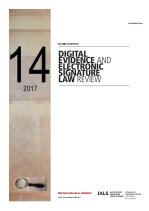Forced biometric authentication – on a recent amendment in the Norwegian Code of Criminal Procedure
DOI:
https://doi.org/10.14296/deeslr.v14i0.2429Abstract
In June 2017 the Norwegian Parliament approved an amendment to section 199 a of the Norwegian Code of Criminal Procedure, allowing the Norwegian police to order anyone dealing with a data-processing system to open it by biometric authentication and to perform the authentication by use of force should the person refuse to comply with the order.
The amendment is the result of a practical situation in which the Norwegian police was, as on many previous occasions, outplayed by technology. In this case, the police had seized the mobile telephone of a person suspected of gross violence, because the police believed the telephone to contain video recordings of the incident, however the suspect refused to provide neither the code or his fingerprint, either of which was necessary to obtain access to the content of the device. After three rounds of court proceedings, the Norwegian Supreme Court decided unanimously that there was no legal basis in Norwegian legislation according to which the suspect could be forced to cooperate (the Biometric case).
The Norwegian government, acting with unusual swiftness, distributed a consultative paper less than four months later, followed by a legislative proposal, which was soon after adopted without amendments. In this article Ingvild Bruce (a research fellow at the Institute of Public and International Law, University of Oslo) outlines briefly the lacunae in Norwegian legislation that caused the need for the amendment; sets out the provision that permits the police to obtain access to biometric authentication by the use of force; the material and procedural conditions that apply, and finally presents some of the objections that were put forward against the proposal and subsequent amendment.
Index words: Norway; biometric authentication; criminal law



